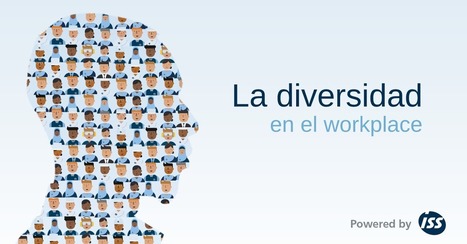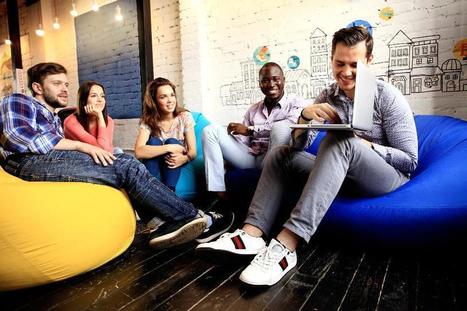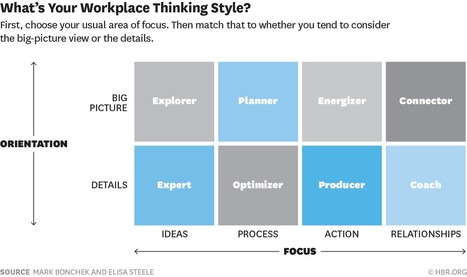 Your new post is loading...
 Your new post is loading...
Every year for the past ten years, Glassdoor announces the top places to work all across North America and parts of Europe. The most unique part of this award? You can only win the award if your employees say so. Glassdoor's methodology for the award includes a collection of anonymous company reviews where employees share their honest opinion on pros and cons of working for the company, overall satisfaction, the CEO, and workplace attributes. They're also asked if they would recommend their employer to a friend. It's a juicy turn of the tables. Within the top 100 best places to work for, the industries that came out on top were tech, retail, healthcare, consulting, finance, and travel and tourism. The top cities included the Bay Area, Boston, and Los Angeles (just to name a few). So, what does it take to be the top of the top?
Via The Learning Factor
Defined hierarchy. Commanding leadership. These corporate ligaments secure firms in the face of threats and unify them against competition. Few beliefs are more widely held in business. The intuition, though, is wrong. “When you look at real organizations, having a clear hierarchy within your firm actually makes people turn on each other when they face an outside threat,” says Lindred Greer, a professor of organizational behavior at Stanford Graduate School of Business. Effective teamwork against threats requires not hierarchy, but egalitarianism; not centralized power, but a culture in which all voices count. Along with Lisanne van Bunderen of the University of Amsterdam and Daan Van Knippenberg of Drexel University, the research team teased out this finding through two complementary studies. In the first study, an experiment, teams of three students developed and pitched a consultancy project to a prospective client. Some of these teams were non-hierarchical, while members of other teams arbitrarily received titles: senior consultant, consultant, junior consultant. Likewise, some teams faced no rivals, while others were told they were competing with a rival firm for clients. The researchers found that the subset of hierarchical teams facing competition with rival firms struggled with infighting while the egalitarian teams cooperated on their work.
Via The Learning Factor
There’s more than one kind of successful organization.
There are few occasions where having high emotional intelligence (EQ) comes in handy more than when you disagree with your boss. But it's hardly the only one. Many of us would even happily trade off a few IQ points in exchange for some extra EQ. In fact, people with very high IQs but lower emotional intelligence may be more likely to upset their bosses by focusing too much on the logical side of an argument while ignoring the social and emotional dimensions. In fact, the most effective approach to disagreeing with your manager should really be based on EQ rather than IQ. Unsurprisingly, research suggests that employees with higher emotional intelligence are generally more rewarding to deal with, which is why they're more often promoted than those who aren't. In a world that still bases so many crucial career decisions on a single subjective factor in the eyes of one's direct manager, likability often trumps ability and work ethic.
Via The Learning Factor
The American work force has never been more diverse, with generations spanning from Baby Boomers to Gen X-ers and beyond. In recent years, however, Millennials (adults aged 19 to 35) have driven the biggest transformation in workplace dynamics. Experts and studies, for instance, tout how the Millennial generation is more collaborative than others and has a strong preference for remote work options. Additionally, Millennial workers are more connected and prefer to use technology to interact and get work done. Why do these insights matter more now than ever before? According to an analysis from Pew Research Center, more than 30 percent of American workers today are Millennials. They recently surpassed Generation X in becoming the largest share of the American work force. As more Baby Boomers retire, more and more Millennials will be stepping up to fill management roles. With Millennials moving into leadership positions, and an even younger generation (Generation Z) preparing to enter the work force, we predict there will be significant changes in office dynamics and operations starting in 2017, and lasting well into the coming years. Here are some typical workplace practices that will become extinct in 2017 and beyond, as younger generations begin to dominate the work force.
Via The Learning Factor
Debido a los cambios demográficos, las empresas han de implementar una estrategia de gestión de la diversidad. Pero, ¿cuál es la mejor manera de hacerlo?
Via mYmO
Charisma isn't just a gift that you have or you don't. Charisma can be learned, and if you can develop charisma, it gives you strong referent power.
Managing change in your organization is as much an art form as it is a scientific approach. The art of change management lies in 3 key fundamentals.
Via Fernanda Grimaldi
Employees who are thanked for a job well done are more engaged, plus expressing gratitude to others makes us happier.
Via Sandeep Gautam
Navigating workplace dynamics can be tough. You have to make the right decisions and avoid the wrong ones, motivate yourself (and others) to achieve common goals, and make all of this work without ruffling anyone feathers. Tough stuff.
But as I talk about in Invisible Influence, there’s a simple, subtle tool that can help us do all this better: social influence. We think our actions are driven by our own thoughts and preferences, but we’re wrong.
Peers have a huge impact on everything we do, from the day-to-day decisions we make to the careers we follow.
Via Mark E. Deschaine, PhD
The state of the modern workplace is evolving, perhaps more quickly than ever. Increases in diversity, the flexibility and scalability that technology provides, the nature of benefits and work environment that employees are willing to demand—all contribute to an ever-changing dynamic that’s exciting for workers and, to a certain extent, a challenge for employers. To get a sense of the state of the modern workplace – and a hint at where it may be heading – international professional services firm, PricewaterhouseCoopers (PwC), conducted focus groups in New York City and online surveys this past May, with 1,385 workers of all types. PwC also surveyed 200 C-Level executives of small to large companies to get an employers’ perspective. The study yielded some interesting results, showing how employees in the modern workplace are feeling, what motivates them, what they feel is important and how they see their futures. Justin Sturrock, People & Organization leader at PwC, admitted that his organization’s survey merely grazes the surface of complex issues facing employers and companies today and in the near future.
Via The Learning Factor
Have you ever worked hard to improve a valuable skill and made real progress, only to have your development go unnoticed by the people who told you that you needed to improve? Perhaps this led you to look for a new job. Or maybe you’re a manager who’s been disappointed by poor performance and concluded that your low-performing employees are simply over-entitled? So you gave up on trying to help them improve and vented your frustration with colleagues behind closed doors. Both of these commonplace experiences point to problems caused by a fixed mindset, in which we find it hard to believe that people can change. In the first scenario, an employee is judged as having low potential—and this assessment blinds leaders to the progress he’s made. In the second, the manager’s conviction that her employees will never change makes her less likely to engage in leadership behaviors that support development. The bottom line in both cases is that employees are less likely to reach their potential.
Via The Learning Factor, Kevin Watson
|
We thought 2016 was a year of turning points. But we had no idea how 2017 would shape up to hold far more moments that affected the workplace, from the current administration’s changing positions on labor policy issues, to whistleblowers sounding the alarm on sexism, racism, and other unfair practices, to the shifting demographics of the workforce itself with the first members of gen Z making their entry into full-time employment. Here is a look at some of the more significant trends that will continue to dominate the conversation around work in 2018.
Via The Learning Factor
Every office runs into some form of distraction that plagues the workplace. Distractions are incredibly common and can damage productivity, focus and employee morale. In fact, a 2015 survey from Oxford Economics found that employee satisfaction and productivity are affected quite negatively by distractions in the workplace specifically caused by cubicle setups. However, cubicle farms aren’t the only reasons distractions occur. Here are some of the most common distractions plaguing the workplace and how employers can easily overcome them.
Via The Learning Factor
This was a "remarkable" year for hiring, according to Glassdoor’s chief economist, Andrew Chamberlain. He says that the U.S. added an average 180,000 new jobs per month, well above the "break even" pace of job growth of 50,000 to 110,000 economists estimate the economy needs to keep Americans fully employed. Pay is also on the rise. Median base pay for U.S. workers was up 3.1% from 2015, the fastest pace in three years. Can we top all that in 2017? According to Glassdoor’s newest report on job trends, there are also a record number of unfilled jobs—5.85 million as of April—which represents the most since the BLS started tracking job openings in 2000. That’s compounded with the fact that every employer is hiring for tech roles, Chamberlain observes, and there are just so many talented candidates out there.
Via The Learning Factor
It’s no secret that a well-designed workplace is a more pleasant environment to spend work hours than one that is poorly planned and decorated. However, spiffier digs could also have an impact on your company’s financial health. A new survey by the International Interior Design Association (IIDA) found a correlation between office design and the bottom line. The survey queried 1,206 full-time U.S. employees at companies of various sizes. More than half are in managerial or professional level positions who spend most of their working time in an office leased or owned by their employer. Respondents to the survey exhibited attitudes that suggest there is a strong correlation between good office design and retention.
Via The Learning Factor
We all hear about the importance of injecting fun into the workplace, and research has proven the benefits of fun. One recent study of 2,000 employees, conducted by Professor Sir Cary Cooper with BrightHR, showed that integrating fun into the workplace reduces absences, increases productivity and reduces stress. Ditching the doldrums is becoming even more important as millennials continue to make up a larger percentage of the workforce. The Cooper/BrightHR study also showed that 79% of graduates believe fun at work is important. 44% believe it encourages a stronger work ethic. Dave Hemsath, author of 301 Ways To Have Fun At Work, believes fun may be the single most important trait of a highly effective and successful organization. In fact, companies with “fun policies” cite greater job satisfaction and increased employee loyalty as two major benefits. So the value is there. But how do you turn your workplace into a funplace? There are lots of ways to add play to work, ranging from the office environment to experiences beyond the office. In this post, I share some success stories.
Via The Learning Factor
I have been coaching a manager for some time who has had several challenges with her director. My wife and I decided to take a Friday night away from the family for a little rest and planning for 2015. At about 12:30 am my client called to tell me that she had texted her boss and quit her job. I was shocked and somewhat disappointed at her decision. I tried to help her see the upside of all she had been able to accomplish, but her mind was made up. When I asked her why she had decided to leave she responded with tears in her voice, “For two and a half years I have been yelled at and belittled in front of others. I have zero confidence. I feel like a glass that is totally full and running over. I can’t hold anymore. I just can’t take it any longer.”
If your mind starts to wander and you could really use a nap or a candy bar around 2 p.m., you’re not alone. The afternoon slump is real, and it’s your body's response to a drop in your blood-sugar levels as well as its natural circadian rhythm. In fact, one of our strongest biological urges to sleep comes between 1 p.m. and 3 p.m., according to the National Sleep Foundation. Taking the afternoon off isn’t usually an option, but some companies have found some fun and effective hacks for tackling the afternoon slump. 1. DANCE PARTIES Employees at the mortgage lender United Shore look forward to 10-minute dance parties held every Thursday afternoon at 3 p.m. The idea began as a small gathering of five or six people and became so popular that the company installed a dance floor on the second floor to accommodate a crowd of more than 100. "We have a lot of team members at United Shore who work from their desks and are focused on hitting their daily goals," says CEO Mat Ishbia. "The dance parties give them a little break to get up, reenergize themselves and get back to their day. That energy helps us stay focused."
Via The Learning Factor
Stand-up desks, wellness programs, flexible schedules, financial consulting, access to health professionals, and a strong emphasis on employee recognition have all recently become focal points at many workplaces. It makes you wonder why leaders are suddenly so keen to create workspaces and cultures that bind teams together and make employees (dare we say it) happy and healthy to be at work. Our world, as we’ve seen recently in the news, isn’t getting any softer. However, research shows that companies that focus on creating happy, healthier, motivating, and appreciative workplaces are onto something profound—even, and maybe especially, during turbulent times. It’s not about creating atmospheres lined with rainbows and butterflies either. Instead, these studies prove the “hard” impact a workplace environment has on productivity and engagement—on both the individual and team level. Read on to discover which traits in your workplace are helping you achieve your best possible outcomes, and which might be derailing your potential. You’ve got allotted breaks—and you take them. It sounds almost too good to be true, but research has shown that regular breaks are crucial to productivity. Your brain needs a breather in between tasks so it can fully focus and engage when you need it to. In fact, the most productive employees take a full 17-minute break for every 52 minutes of concentration. Try their pattern out for a day, and see if it makes a difference. Even switching to a simpler task can count as a breather. Just remember the benefits of taking a break the next time you’re tempted to skip yours—because even just five minutes off can make a big difference.
Via The Learning Factor
Managers have an opportunity to interrupt a sometimes vicious cycle between trust and commitment.
Via Marc Wachtfogel, Ph.D.
You need different mental models at different times.
Learn how to recruit people with a great attitude to work.
If the answer to these last two questions is “rarely,” it wouldn’t surprise us. We don’t believe that swift, wholesale culture change is possible — or even desirable. After all, a company’s culture is its basic personality, the essence of how its people interact and work. However, it is an elusively complex entity that survives and evolves mostly through gradual shifts in leadership, strategy, and other circumstances. We find the most useful definition is also the simplest: Culture is the self-sustaining pattern of behavior that determines how things are done. Made of instinctive, repetitive habits and emotional responses, culture can’t be copied or easily pinned down. Corporate cultures are constantly self-renewing and slowly evolving: What people feel, think, and believe is reflected and shaped by the way they go about their business. Formal efforts to change a culture (to replace it with something entirely new and different) seldom manage to get to the heart of what motivates people, what makes them tick. Strongly worded memos from on high are deleted within hours. You can plaster the walls with large banners proclaiming new values, but people will go about their days, right beneath those signs, continuing with the habits that are familiar and comfortable. But this inherent complexity shouldn’t deter leaders from trying to use culture as a lever. If you cannot simply replace the entire machine, work on realigning some of the more useful cogs. The name of the game is making use of what you cannot change by using some of the emotional forces within your current culture differently.
Via The Learning Factor
|



 Your new post is loading...
Your new post is loading...













































To be a desirable place to work for, making employees feel valuable and providing a competitive salary is only part of the equation.